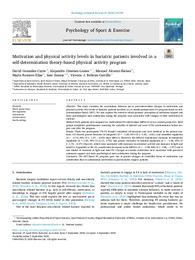Título :
Motivation and physical activity levels in bariatric patients involved in a self-determination theory-based physical activity program |
Autor :
González-Cutre, David
Jiménez-Loaisa, Alejandro 
Alcaraz-Ibáñez, Manuel 
Romero-Elías, María 
Santos, Inés
Beltrán-Carrillo, Vicente J.  |
Editor :
Elsevier |
Departamento:
Departamentos de la UMH::Ciencias del Deporte |
Fecha de publicación:
2020-09 |
URI :
https://hdl.handle.net/11000/32939 |
Resumen :
Objective: This study examines the associations between pre-to post-intervention changes in motivation and
physical activity (PA) levels of bariatric patients involved in a 6-month postoperative PA program based on selfdetermination theory (SDT). We also explore the extent to which patients’ perception of autonomy support and
basic psychological need satisfaction during the program were associated with changes in their motivation to
exercise.
Method: Forty patients were assigned to a motivational PA intervention (MPAI-G) or to a control group (CG). Both
groups completed questionnaires assessing the variables of interest and wore GT3X accelerometers before surgery and after the program.
Results: Thirty-two participants (78.1% female) completed all measures and were included in the present analyses. CG showed greater increases in integrated (d = − 1.60, 95% CI [− 2.40, − 0.81]) and identified regulation
(d = − 0.75, 95% CI [− 1.47, − 0.03]) than MPAI-G. However, the MPAI-G experienced increases in introjected
regulation (d = 1.95, 95% CI [1.11, 2.79]) and greater decreases in external regulation (d = − 1.00, 95% CI
[− 1.74, − 0.27]) than CG, which were associated with decreases in sedentary activity and increases in light and
total PA. Oppositely to the CG, amotivation decreased in the MPAI-G (d = − 2.98, 95% CI [− 3.98, − 1.97]) and it
was related to increases in light and total PA. Changes in exercise motivation were associated with perceived
autonomy support and basic psychological need satisfaction during the program.
Conclusion: The SDT-based PA program gave rise to greater changes in controlled forms of motivation and
amotivation than in autonomous motivation in post-bariatric surgery patients.
|
Palabras clave/Materias:
Sleeve gastrectomy
Self-regulation
Amotivation
Accelerometer
Health settings |
Área de conocimiento :
CDU: Bellas artes: Diversiones. Espectáculos. Cine. Teatro. Danza. Juegos.Deportes |
Tipo de documento :
info:eu-repo/semantics/article |
Derechos de acceso:
info:eu-repo/semantics/openAccess
Attribution-NonCommercial-NoDerivatives 4.0 Internacional |
DOI :
https://doi.org/10.1016/j.psychsport.2020.101795 |
Publicado en:
Psychology of Sport & Exercise 51 (2020) 101795 |
Aparece en las colecciones:
Artículos Ciencias del Deporte
|
 La licencia se describe como: Atribución-NonComercial-NoDerivada 4.0 Internacional.
La licencia se describe como: Atribución-NonComercial-NoDerivada 4.0 Internacional.
.png)
